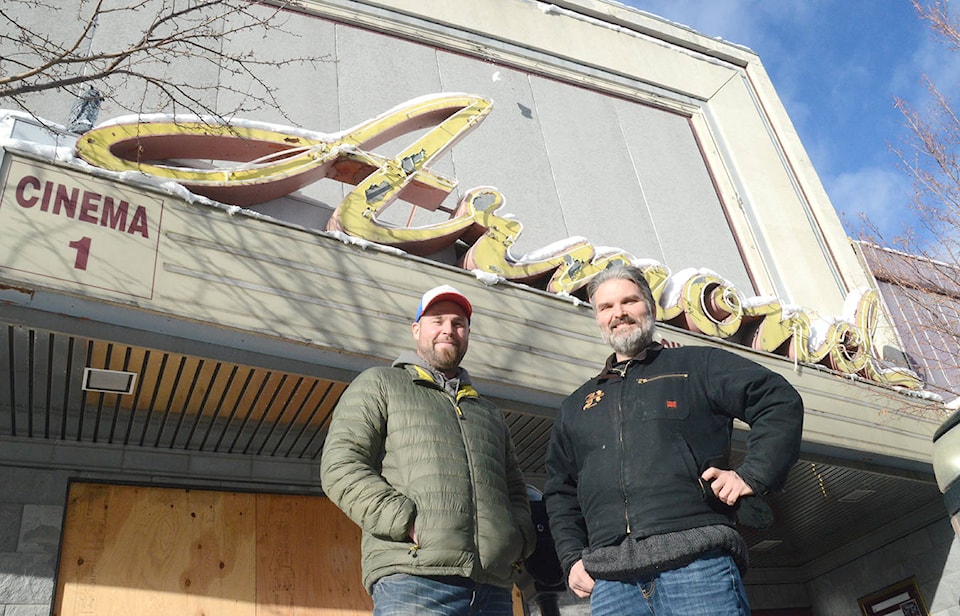A significant Cranbrook heritage landmark is being reborn, and will help bring downtown into a new modern age.
The historic Armond Theatre, which has sat derelict for 20 years on 10th Street downtown, has been purchased by a partnership of three local men, and work is already underway to transform the decrepit 78-year-old building into a multi-purpose community arts centre.
Casey Wright and Spencer Kerr of Casey’s Roofing and Flashing, and Ferdy Belland, local carpenter and musician, bought the building from Jean Trimble, who had bought the old theatre in 2013.
Belland said the new Armond (the name will remain), will eventually be a sumptuous, Art Deco venue for “live music, live theatre, comedy, spoken word, lectures dance recitals, graduations ceremonies, weddings, film festivals, youth-oriented events, seasonal celebrations, cultural celebrations, conferences, conventions — so many other roles for the grand old room to fill.
“The restored interior aesthetic will echo the retro chic art deco stylings — coffered ceilings, wooden wainscoting, hardwood dance floor, wall sconces, velvet drapery, a guided balcony area,” Belland said.
“The interior design will incorporate dedicated acoustic engineering, and will feature a state of the art surround-sound and lighting system.
“We wish the resulting atmosphere of the room to be dramatic, to capture the imagination of the community.”
Belland said the vast upper level balcony means “double-decker audience space is available, and the ability to effectively divide the room into two separate venues if necessary.
“We will be able to accommodate a wide variety of public and private events in the range of 250 to 450 attendees.”
Belland added that the Armond will not be working at cross purposes against established venues such as the Key City Theatre or the Studio Stage Door. In fact, the goal is to create a supportive sibling entity, which will fill the much needed “Goldilocks” spot between those two facilities.
“Partnering with the Key City Theatre Society and Cranbrook Community Theatre among many other local groups is paramount to our mission statement.”
Belland said the Armond plan comes in four phases. Phase One is complete — the purchase of the building has taken place and now work can begin.
Phase Two will be the necessary structural upgrades and hazardous materials abatement needed to bring the Armond Theatre up to modern building code requirements.
“Us three partners are experienced tradesmen who are well up to the task,” Belland said.
Phase Three will be the renovations and installations.
Phase Four will have the finished venue open to the Cranbrook public.
“We’re aiming, tentatively, for sometime in mid-2021,” Belland said. “That’s when our true work begins. We believe a renovated Armond Theatre will be warmly welcomed and received by the Cranbrook community.
Belland said that there are several hundred examples across North America of repurposed decommissioned cinemas.
“We’re not reinventing the wheel.”
Belland said the Armond Theatre has been a dream of his for the better part of a decade.
“I moved back to Cranbrook in 2012, and immediately knew the Armond Theatre needed to be reborn as a multipurpose venue.”
On the site of Cranbrook’s old auditorium, the Armond Theatre opened its doors on March 19, 1952. A packed house flocked to view “An American In Paris” at the new state-of-the-art theatre.
The movie theatre was designed by Vancouver architectural firm Sharp, Thompson, Berwick and Pratt, who also designed campus buildings at the University of British Columbia.
It was named for original managing director Armond Clark Blaine, who passed away before the theatre was completed.
The theatre boasted reinforced concrete construction with “ultra-modern” plastic doors leading into a handsomely appointed foyer. The main floor boasted ‘saucer-type’ seating, acoustically treated walls, air conditioning and the most up-to-date sound system available. A stadium mezzanine (balcony) was also included.
The building stands out on 10th Avenue, downtown Cranbrook, for its neon sign hanging above the awning and a painted Pepsi advertisement on its exterior side.
When the new Columbia Theatre at Tamarack Mall opened in the late 1990s, the Armond saw dwindling numbers, until it finally closed its doors in 1999.
The group has been in discussions with the City of Cranbrook, the Downtown Business Association, the local arts community and others have all been supportive and encouraging. The partnership plans to keep all these groups in the loop throughout the process.
The Armond project joins other ongoing ventures that are changing the downtown cityscape and culture, such as the Fire Hall Kitchen and Tap, the HeidOut Restaurant and Brewhouse, the Mount Baker Hotel and the SoulFood Restaurant.
Belland said a reborn Armond Theatre will help kick-start Cranbrook’s downtown nightlife back into high gear, with ripple effects benefitting established downtown businesses.
“The Armond Theatre will assist in the ongoing efforts of the City of Cranbrook and the Downtown Business Association with downtown revitalization, heritage infrastructure restoration, tourism economy and civic pride,” he said.
“Cranbrook will be exploding throughout the 2020s, and for the better — culturally and economically. We wish the Armond Theatre to be part of this positive upsurge.”
With Townsman files from Jim Cameron and Sally MacDonald
READ MORE: Some history …
READ MORE: The last time the Armond was bought …
